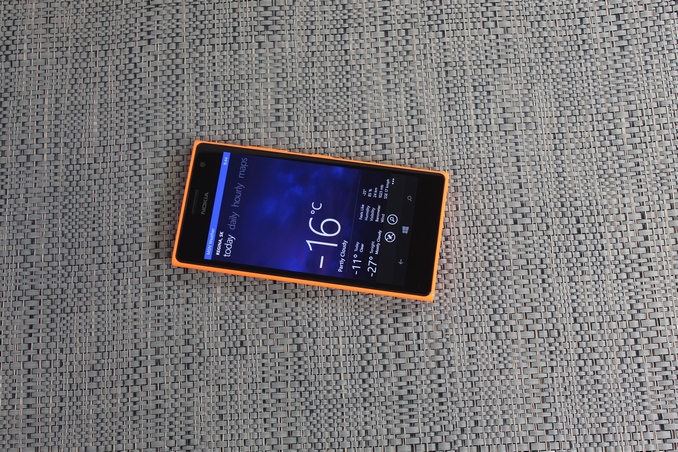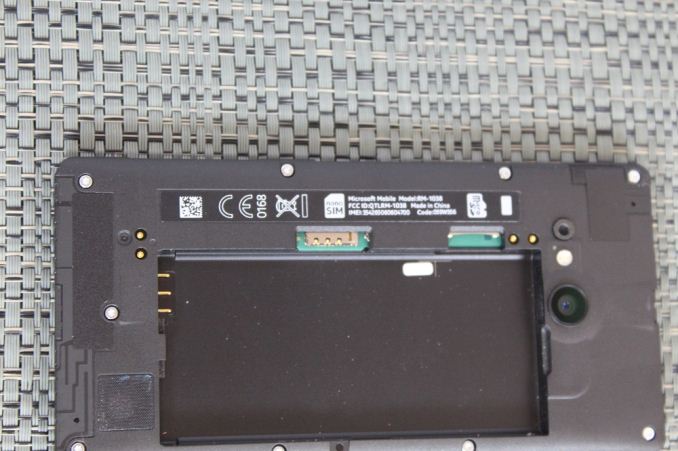Nokia Lumia 735 Review
by Brett Howse on February 3, 2015 6:00 AM EST- Posted in
- Smartphones
- Microsoft
- Nokia
- Lumia

Back in September, Microsoft launched what would be the last two Nokia branded Lumias. The Lumia 830 was announced as an affordable flagship, and we reviewed the 830 back in November. The Lumia 730 and 735 were launched with a different feature set, a lower price, and a higher resolution front facing camera. Microsoft announced them as “built for Skype calls and selfies” with the inclusion of the five megapixel front facing camera and put the package in a smaller, lighter body. It was launched with four colors, with the 730 being a dual SIM version and the 735 is a single SIM with LTE capabilities.
Right after our Lumia 830 review, Microsoft asked if I would like to review the 735 as well. Although many of the internals are similar or identical to the 830 and 630, there is enough different that this is really a unique phone in the Lumia range. It lacks the PureView branded camera system, but still has a good camera. The OLED display is 720p, which is a step up from the lower cost 630, and the same resolution as the 830, but in a slightly smaller screen size. At 4.7”, this is the only Lumia available at this size.
The Lumia 830 tried to put a higher end package together with the metal frame, 5” display, and a PureView 10 MP camera with OIS into a less expensive price bracket. Although the SoC in the 830 is only a Snapdragon 400, it is overall a great phone which is hampered only by its price. The 735 steps the price down further and packages the phone in a more traditional Lumia style with a fully polycarbonate body.
| Nokia Lumia 735 | Nokia Lumia 830 | |
| SoC | MSM8926 1.2 GHz Snapdragon 400 | MSM8926 1.2 GHz Snapdragon 400 |
| RAM/NAND | 1 GB LPDDR2, 8 GB NAND + microSD 128 GB |
1 GB LPDDR2, 16 GB NAND + microSD 128 GB |
| Display | 4.7” 1280x720 ClearBlack OLED Corning Gorilla Glass 3 |
5.0” 1280x720 IPS ClearBlack LCD Corning Gorilla Glass 3 |
| Network | GSM/GPRS/EDGE/HSPA/LTE up to 150 Mbps |
GSM/GPRS/EDGE/HSPA/LTE up to 150 Mbps |
| Dimensions | 134.7 x 68.5 x 8.9 (mm) | 139.4 x 70.7 x 8.5 (mm) |
| Weight | 134.3 grams | 150 grams |
| Rear Camera | 6.7MP, 1.4 µm pixels, 1/3.4" 16x9 CMOS, f/1.9, 26 mm focal length, LED Flash |
10MP, 1.1 µm pixels, 1/3.4" 16x9 CMOS, f/2.2, 26 mm focal length, LED Flash |
| Front Camera | 5MP wide angle, f/2.4, 1920x1080 video resolution |
0.9MP wide angle, f/2.4, 1280x720 video resolution |
| Battery | 2200 mAh, 3.8 V, 7.04 Wh | BV-L4A 2200 mAh, 3.8 V, 7.04 Wh |
| OS | Windows Phone 8.1 with Lumia Denim Firmware |
Windows Phone 8.1 with Lumia Denim Firmware |
| Connectivity | 802.11 b/g/n (2.4 GHz) + BT 4.0, USB2.0, DLNA, FM Radio |
802.11 a/b/g/n + BT 4.0, USB2.0, DLNA, FM Radio |
| Location Technologies |
Cellular and Wi-Fi network positioning, A-GPS, A-GLONASS, BeiDou |
Cellular and Wi-Fi network positioning, A-GPS, A-GLONASS, BeiDou |
| SIM Size | Nano SIM, Dual-SIM HSPA on Lumia 730 |
Nano SIM |
Internally, it is very similar to the Lumia 830. The Snapdragon 400 MSM8926 provides the quad-core Cortex A7 at 1.2 GHz, as well as the LTE modem. Memory is identical at 1 GB of LPDDR2, which opens the entire range of Windows Store apps to this device. The OLED display also features ClearBlack, which is a polarizing filter to keep refractions and reflections from outside lighting to a minimum. Storage is less than the Lumia 830, with only 8 GB of internal NAND available. A micro SD card slot allows an additional 128 GB to be added, and Windows Phone’s Storage Sense app makes it easy to control where your data gets stored. The latest update to Windows Phone also allows future software updates to be staged to the SD card, making the 8 GB not as much of a detriment as on other platforms.
One rather large omission, which is available on the Lumia 830, is Glance screen support. Every Lumia should have Glance, as it is one of the best features. Because this one does not, it is a big knock against it, especially when moving from an older Lumia with Glance support.











64 Comments
View All Comments
Brett Howse - Tuesday, February 3, 2015 - link
The Glance screen app is only available to phones with the correct hardware to use it unfortunately. Would be nice if it was just an app.noblemo - Friday, February 13, 2015 - link
The slow Wi-Fi means disabling your 5GHz radio or upgrading to an access point with simultaneous 2.4/5GHz coverage. I ran into this issue when I bought a Lumia 635 as a house phone. Now I have to run my laptop and Icon on congested 2.4GHz when no one else in the area is running 5GHz. First World problem, but still annoying.nathanddrews - Tuesday, February 3, 2015 - link
In all honesty, I'm waiting to upgrade my S3 to an Intel-X86-powered, Windows 10 phone. We're almost there.http://makeameme.org/media/created/almost-there-al...
juan96 - Tuesday, February 3, 2015 - link
For display test, I know that Anandtech uses Calman SW and i1Pro for measuring . But I curious, how they input test pattern to cell phone? As anybody knows, MicroUSB port of cellphone is output only.deltaman - Tuesday, February 3, 2015 - link
Actually, Lumia phones DO support transferring data in BOTH directions via the micro USB port; the phone mounts like any other USB storage device when connected to a Windows machine, & M'soft offers a free utility for file transfers to/from Mac OS devices...juan96 - Tuesday, February 3, 2015 - link
Yes, I misunderstood. MicroUSB is not only for output. But I still didn't find the solution to use Android tablet uses as display device like monitor.tipoo - Tuesday, February 3, 2015 - link
With 720p and MicroSD thrown in, it could be a decent Moto G competitor. I wish they at least upgraded to the Snapdragon 410 though.tipoo - Tuesday, February 3, 2015 - link
It's pretty silly how poorly the WP browser does against the equivalent SoC in an Android phone. Sunspider is the only thing it does well in, and we know Microsoft targeted that for optimizations, making it less of a real world result. They don't even have a terrible rendering engine on the desktop side, so I don't get why they continue to underperform so much on the mobile side.tipoo - Tuesday, February 3, 2015 - link
And the GPU too, what is with that?Brett Howse - Tuesday, February 3, 2015 - link
This will finally be resolved when Spartan is the new browser in Windows Phone 10. Not that this is any excuse for the poor implementation now, but finally, browser performance seems to be a priority.